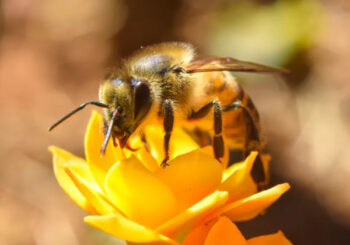By Lily Anderson
Staff Writer for Wake Up World
In a world where the survival of countless plant species depends on the vital pollination services provided by bees, a recent study from Trinity College Dublin and Dublin City University has cast a dark shadow over Ireland’s buzzing pollinators. This ground-breaking research delves into the unsettling reality of widespread pesticide exposure faced by various bee species, challenging the conventional wisdom that honey bees alone can serve as a reliable barometer of pesticide risk.
Published in the prestigious journal Science of the Total Environment, this study’s findings have raised red flags, unveiling a complex web of pesticide residues impacting both honey bees and bumble bees across the Emerald Isle.
Pesticide Perils: The Study’s Key Takeaways
Long-lasting Chemical Legacy
One of the most disconcerting revelations from the study is the presence of pesticides in crop pollen, even when these chemicals had not been recently applied to the sampled fields. This suggests that certain chemicals have a remarkable persistence in the environment, possibly lingering in the soil and subsequently finding their way into crop pollen. Furthermore, residues may originate from plants situated within the foraging radius of bees, exposing them to pesticides in unexpected places.
Crop vs. Bee Pollen: A Stark Contrast
The study uncovered a stark difference in the types of pesticides found in crop pollen compared to bee-collected pollen. While crop pollen showed contamination predominantly with fungicides, honey bee pollen was similarly tainted. In contrast, bumble bee pollen exhibited a higher prevalence of neonicotinoid insecticides.
Bumble Bees Bear the Brunt
Perhaps the most alarming discovery was the disproportionately high number of pesticide compounds found in bumble bee pollen. Even more concerning was the fact that all five neonicotinoid insecticides assessed in the study were detected in bumble bee pollen, despite not having been recently applied to the sampled fields. This raises questions about the persistence of these toxic chemicals in field edges, where wildflowers flourish, or whether bees are foraging for neonicotinoid-contaminated pollen beyond the sampled fields.
Combined Pesticide Toxicity
The study’s findings also shine a spotlight on the potential compounding effect of insecticides and fungicides when encountered together. Previous research suggests that the combination of these two categories of pesticides may lead to heightened toxicity, surpassing the risks posed by each category individually.
Insights from Elena Zioga, PhD Candidate
Elena Zioga, the lead author of the study and a PhD Candidate in Trinity’s School of Natural Sciences, expressed her concerns about the implications of these findings:
The results of this study are concerning on several levels. Of particularly great significance is the indication that different species seem to be exposed to pesticides differently based on the variation in the types and number of different pesticides found in pollen of honey and bumble bees respectively.
Essentially, this means that using honey bees as a reference for understanding the exposure to different pesticides cannot give a complete picture. What’s true for honey bees doesn’t seem to be true for bumble bees, and we know that both are important for the overall pollination service and for supporting healthy ecosystems.
It is also very worrying that the five neonicotinoids we looked for appeared in bumble bee pollen and not in crop pollen. Some of these pesticides, known to be particularly toxic, had not been applied in the fields we sampled for at least three years. This shows either that they persist for a long time in the field edges, where wildflowers grow, or that bees collected neonicotinoid-contaminated pollen from beyond the sampled fields. Our work also showed that neonicotinoid detection increased when the presence of wild plants in bumble bee pollen increased, and that is one of many things that require further investigation.
Conclusion
The findings of this research are a stark reminder of the intricate web of challenges faced by bees in their daily quest for nectar and pollen. As these tiny pollinators continue to struggle against the threat of pesticides, it becomes increasingly evident that a one-size-fits-all approach to understanding their exposure simply won’t suffice. Safeguarding the future of both honey bees and bumble bees requires a nuanced understanding of how different species interact with these chemicals and how they may compound each other’s toxicity.
It is a call to action for policymakers, farmers, and the public alike to revaluate the use of pesticides and their impact on our precious pollinators. As the study from Trinity College Dublin and Dublin City University illuminates, the survival of bees—and by extension, our ecosystems and food supply—hangs in the balance.
Reference:
- Elena Zioga, Blánaid White, Jane C. Stout. Honey bees and bumble bees may be exposed to pesticides differently when foraging on agricultural areas. PLOS ONE DOI: 10.1016/j.scitotenv.2023.166214
About the author:
Lily Anderson is a passionate wordsmith and dedicated explorer of cutting-edge scientific inquiries. Fuelled by a thirst for knowledge, she skilfully transforms intricate ideas into relatable tales, inviting readers to embark on a captivating expedition of revelation. Lily’s efforts play a crucial role in bridging the gap between experts and the wider public, evoking a sense of awe and encouraging insightful discussions about groundbreaking scientific advancements.

If you've found value in our articles, we invite you to support the release of our brand-new book, "Gratitude Practices for Kids: A Practical Guide for Adults to Instill a Spirit of Appreciation and Positivity in the Next Generation."
"Gratitude Practices for Kids" brings together over 25 innovative and accessible practices designed to enhance gratitude in everyday life. This comprehensive guide is backed by 17 scientific studies, ensuring each concept is grounded in research, underscoring our commitment to nurturing growth, emotional intelligence, and positive interactions between adults and children.
We encourage you to opt for the paperback version to celebrate this new release. Dive into its fresh pages away from digital distractions, allowing you to immerse yourself in the transformative practices it offers.
Over recent years, Wake Up World has faced significant online censorship, which has impacted our financial ability to operate. Moving into book publishing represents a strategic step to secure the ongoing funds needed to continue our mission. By purchasing Gratitude for Kids, you help us keep our content free and accessible to everyone, avoiding needing a paywall. With over 8,500 articles published in the last 13 years, we remain dedicated to keeping our valuable content open to all.









